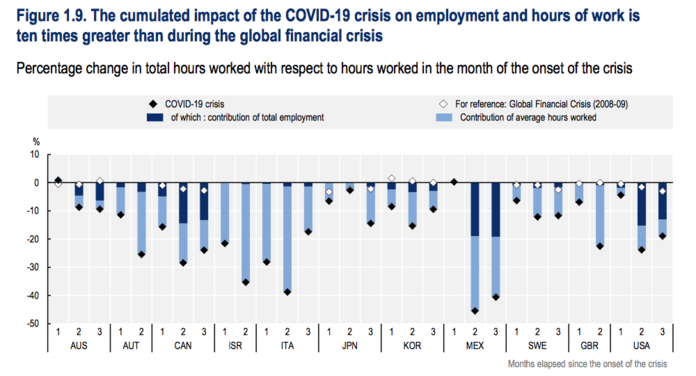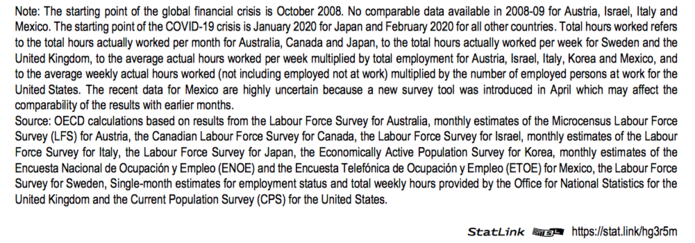According to the report “the most serious pandemic in a century has triggered one of the worst economic crises since the Great Depression”. This crisis represents a drop in OECD-wide GDP of almost 15% and a projection of a 6% annual decline in global GDP for 2020. The OECD-wide projections place unemployment rate at 9.4% at the end of 2020, and at 7.7% in 2021.
By presenting data and charts on generally increasing unemployment rates across OECD countries, it highlights that “unemployment rates at this stage offer only partial guidance on the extent of the labour market crisis across OECD countries”. This depends on the type of support provided to workers, ranging from unemployment insurance benefits to job retention schemes. To better understand the impact of the crisis on the labour market, OECD decided to analyse the unemployment rate and the decrease in hours of work together. It found that “the cumulated impact of the COVID-19 crisis on employment and hours of work is ten times greater than during the global financial crisis”.


The Outlook did not present much information on the employers’ difficulties to remain afloat and to maintain the same level of employment. It reported “OECD estimates that without public support, 20% of firms would have faced a liquidity crisis after the first month of lockdown, and 40% after three months. […] A series of corporate bankruptcies would severely disrupt not only value chains but also the banking and financial system. Well aware of these risks, all OECD countries adopted a vast range of emergency measures aimed at supporting firms’ liquidity in addition to the monetary measures taken by central banks. These ranged from deferrals in tax and social-security contributions to liquidity injections through equity participation, direct subsidies based on past sales, subsidies for maintaining employment, grants. Many countries also took specific measures to support small and medium enterprises (SMEs), which usually face stronger liquidity constraints”.
Social dialogue practices were barely mentioned in the report as a way to enhance occupational health and safety and as good examples “to complement public action and find flexible and tailored solutions for both companies and workers”.
In the foreword to the Outlook, Angel Gurría, OECD Secretary-General, recommended “to sustain the recovery with a combination of macroeconomic policies and sectoral policies to boost growth and job creation while providing support to the many still in need. Policies need to sustain public and private investment, especially on green and other essential infrastructure and more generally to foster job creation. Moreover, policy makers will need to modify and adjust the composition and characteristics of their support packages, targeting support where it is most needed and encouraging a return to work where possible. If they get these decisions right, we will be able to look back on 2020 as a year of crisis, successfully navigated. Get them wrong, and the consequences will be felt by many people for a long time”.
From an employers’ perspective, the Outlook’s provides very useful insights and recommendations. Its high quality data are of relevance for advancing on economic and social policy discussions. It also presents some contradictions with the most general OECD policy recommendations on workers’ protection. The former seems to promote an absolute need to be in a open-ended full time employment, while the latter refers to the urgency of establishing safety nets and skilling that accommodate labor market dynamics, transitions and new ways of working. Additionally, the report keeps showing a dualism between regular employment and “non-standards jobs”: this binary distinction does not reflect the reality, especially for OECD members from Latin America with a high level of informality (the latest to join OECD was Colombia). Moreover, there seems to be little information on the role played by private employment services into the crisis and there is large evidence of the positive impact of these services in the allocation of workers from sectors on hold to sectors in need.
In the months to come, more information will be provided on the employers’ views on the report transmitted through BIAC (Business at OECD) and especially on Chapter 2 on the comparative review and updated indicators on EPL.